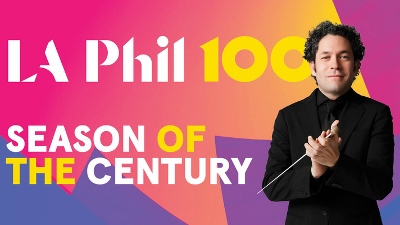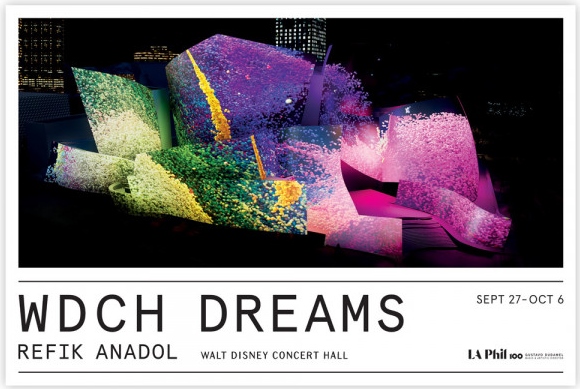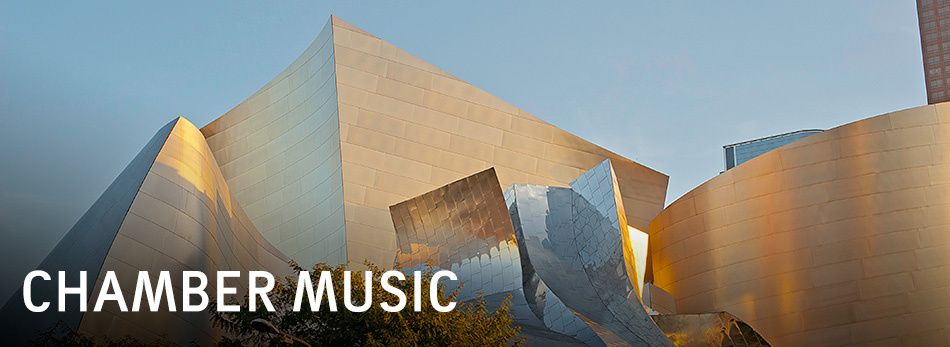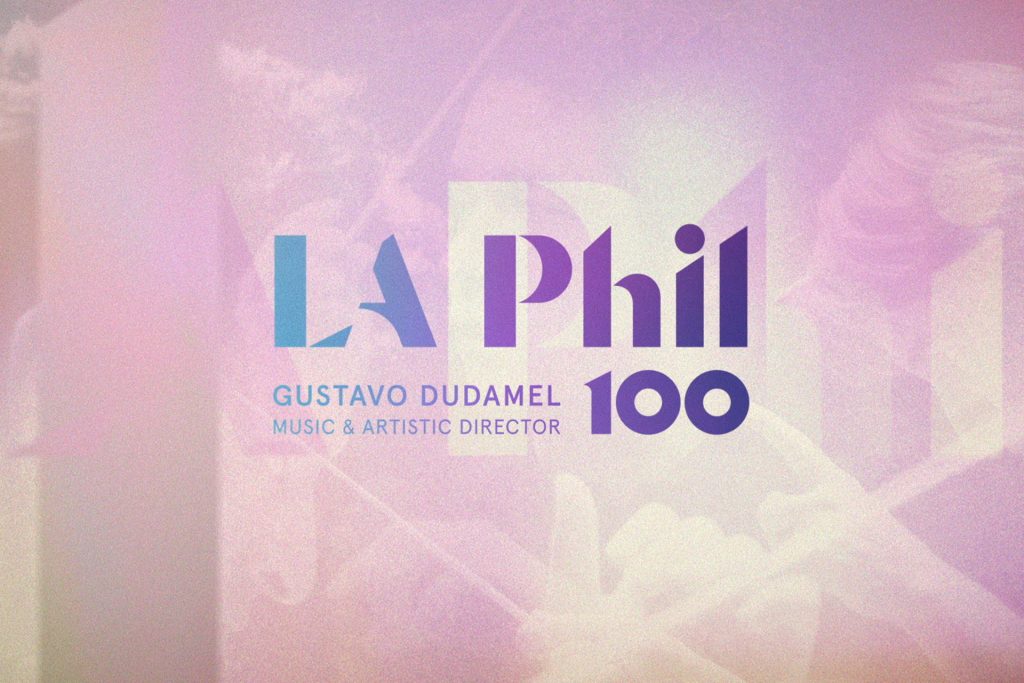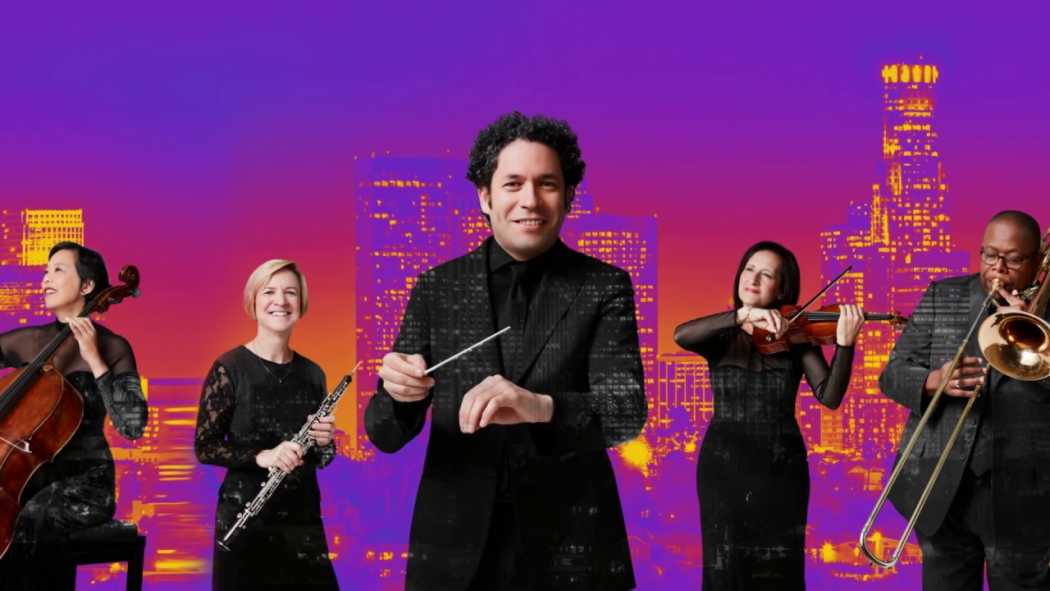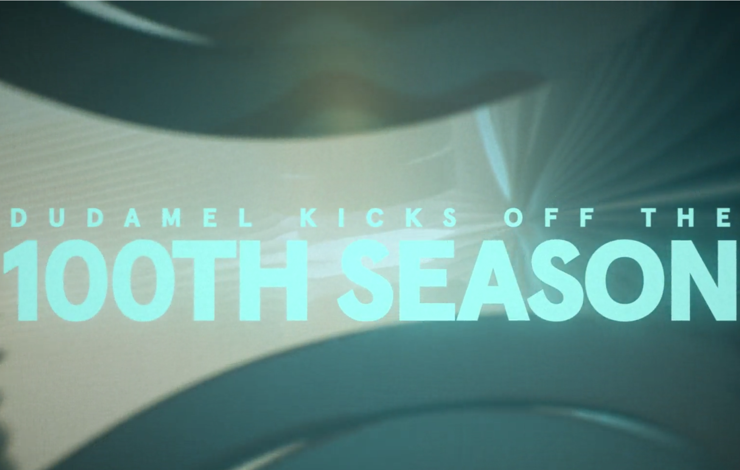ONE WAY OR ANOTHER, YOU’LL GET YOUR PHIL
 It’s been quite a week for our Los Angeles Philharmonic, which starts its second century with a slew of performances that has slathered the city with festivities and honor. Angelinos should be rightfully proud that our orchestra is celebrating all things artistic — musically and socially — all over town, because its that fabric of our cultural quilt which is the bedrock of our symphony, poised to becoming the best in the world.
It’s been quite a week for our Los Angeles Philharmonic, which starts its second century with a slew of performances that has slathered the city with festivities and honor. Angelinos should be rightfully proud that our orchestra is celebrating all things artistic — musically and socially — all over town, because its that fabric of our cultural quilt which is the bedrock of our symphony, poised to becoming the best in the world.
I hope you got to enjoy some of the eight miles of play when denizens and bicyclists reveled on during the Celebrate LA: LA Phil 100 x CicLAvia. This gift to the city was palpable. The incredible energy Sunday, September 30, in the streets of Hollywood was that of joyful community, and when the Jazz at Lincoln Center Orchestra with Wynton Marsalis played an hour-long gig on a stage under the Capital building, it wasn’t just the greatest free jazz concert I’ve heard, it was the best, period. (And this following the delightfully droll raconteur, actor, and jazz pianist Jeff Goldblum, who made small talk and stumped the crowd with movie trivia between songs with the Mildred Snitzer Orchestra.)
And then there was media artist Refik Anadol’s phantasmagoria, WDCH Dreams. which sadly only played for a short window. This awesome installation projected onto Disney Hall actually made the building look as though its undulating. Across Grand on the top level of the parking lot, viewers sat on bleachers as the soundscape permeated our senses.
But really the most important aspects of the LA Phil are the instrumentalists and their helmsman. Under Gustavo Dudamel’s artistic leadership, new faces are showing up on stage and, as Principal Second Violinist Lyndon Johnston Taylor announced prior to the All-Russian Chamber Music program last Tuesday, every player in the orchestra is a virtuoso. (Say what you will about this year’s programming — a daunting display of war horses, new music, and mash-ups of pop and classical — you’ll never be sorry you attended any event.)
The orchestra’s vision of excellence truly manifested itself as members of the LA Phil brought to vivid life the Prokofiev Sonata for Two Violins, Op. 56; Shostakovich’s Piano Trio No. 2 in E minor; and Tchaikovsky’s String Sextet, Souvenir de Florence. With the Phil’s gigantic flurry of endeavors, this sterling event simply came in under the radar, so it was a shame the house was only about half-full.
I’m going out on a limb here, but first let me say that Disney Hall isn’t really conducive to salon-type music, at least not in this configuration. Perhaps one day the empty circular risers behind the players will be filled with chairs, and the orchestra view seats will be sold so that music which is not geared for a giant hall such as this can be better contained. And the past few years has seen a rise to the already hefty salon-type performances and chamber outfits in L.A., and oftentimes — from Da Camera to Dilijan to Camerata Pacifica to Le Salon de Musiques — intimacy is key.
But by God, the work on display was stunning, and it was the finest evening of chamber work I have yet seen at Disney Hall. Remarkably accomplished and chock-full of character, Dr. Taylor and China-born Tianyun Jia (a Phil member since 2017) — both extremely honeytoned-but-cocksure violinists — turned in a no-holds-barred attack performance of the 1932 Sonata for Two Violins that was both lyrical enough for the work’s melodies and acerbic enough for its harmonies, driven enough for the fast movements, and tender enough for the slow. They enlivened all of the spicy dissonances, but the tight call-and-response in the allegro of this neoclassically designed 14-minute piece was especially thrilling.
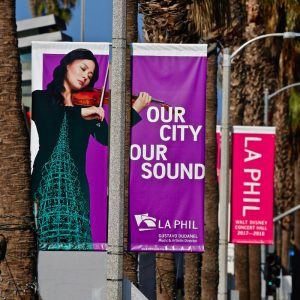 Performing the demanding but intoxicatingly beautiful Piano Trio in E minor, Opus 67, was Mark Kashper, violin (with the Phil since ’79), Dr. Lucy Nargizyan, piano, and L.A. native Barry Gold, cello. This 1944 work bears marks of the war years in Europe and the world, but given the angst (the work is a lamentation for Shostakovich’s close friend, musicologist Ivan Sollertinsky) there’s a surprising amount of light passages that may be the composer’s flippancy, as he never quite lined up with his country’s authoritarian ways. This is among the best pieces in his incredibly rich chamber music output, but this was the most exciting rendering I’ve ever heard, with concise communication that made the trio sound as if they had been playing together for years. And it was tight from the start: the first movement begins with an Andante canon, the melody played first by Gold’s sweet cello in harmonics, which makes it the top voice, then Kashper’s stern violin, which becomes the lower string voice, followed by Nargizyan’s liquid piano in the lowest register. Later, the strings impressively played their pizzicatos lard and sharp. I believe Nargizyan had the greatest workout here, but whether the music was savage or witty, she always made it joyful.
Performing the demanding but intoxicatingly beautiful Piano Trio in E minor, Opus 67, was Mark Kashper, violin (with the Phil since ’79), Dr. Lucy Nargizyan, piano, and L.A. native Barry Gold, cello. This 1944 work bears marks of the war years in Europe and the world, but given the angst (the work is a lamentation for Shostakovich’s close friend, musicologist Ivan Sollertinsky) there’s a surprising amount of light passages that may be the composer’s flippancy, as he never quite lined up with his country’s authoritarian ways. This is among the best pieces in his incredibly rich chamber music output, but this was the most exciting rendering I’ve ever heard, with concise communication that made the trio sound as if they had been playing together for years. And it was tight from the start: the first movement begins with an Andante canon, the melody played first by Gold’s sweet cello in harmonics, which makes it the top voice, then Kashper’s stern violin, which becomes the lower string voice, followed by Nargizyan’s liquid piano in the lowest register. Later, the strings impressively played their pizzicatos lard and sharp. I believe Nargizyan had the greatest workout here, but whether the music was savage or witty, she always made it joyful.
I have recordings of the lighthearted and fetchingly effusive Souvenir de Florence done by quartet, string section, and sextet (the composer’s original guise), my favorite being Borodin with Rostropovich. Knowing that these players work together in the orchestra, I was somewhat skeptical that they could play like a well-oiled team as a tiny band. Well, they ensured the second half of the evening was just as stunning as the first. Offering fantastic shading and vigor with scrupulous attention to detail, the 35-minute work was as sunny as the skies under which Tchaikovsky composed his string sextet in 1890. Violins: First Associate Concertmaster Nathan Cole (with the Phil since 2011) and his wife Assistant Concertmaster Akiko Tarumoto (first joined in 2000, then back in 2011); Violas: Assistant Principal Ben Ullory (2012) and L.A. native Ingrid Hutman (1991); and Cellos: Assistant Principal Dahae Kim (2016) and Gloria Lum (1985).
The big guns came out for the four performances which ended yesterday: Gustavo Dudamel led the orchestra in a program that included Esa-Pekka Salonen’s LA Variations; the Beethoven Triple Concerto (with LA Phil principals Martin Chalifour, violin; Robert deMaine, cello; and Joanne Pearce Martin, piano, as soloists); and the world premiere of a major new work by Andrew Norman titled Sustain, which was commissioned by the LA Phil for the Centennial.
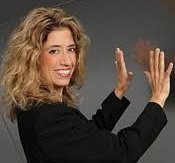 It’s understandable that Beethoven’s 1803 Triple Concerto was chosen to open the season: It’s a perfect way to show off the virtuosity of the soloists — all principals in their sections. It’s a concerto in that three soloists are on prominent display, and a symphony in that the soloists are nonetheless discernibly a part of the total ensemble and not preeminent. The parts of the soloists are of equal importance and the balance between them was particularly researched by
It’s understandable that Beethoven’s 1803 Triple Concerto was chosen to open the season: It’s a perfect way to show off the virtuosity of the soloists — all principals in their sections. It’s a concerto in that three soloists are on prominent display, and a symphony in that the soloists are nonetheless discernibly a part of the total ensemble and not preeminent. The parts of the soloists are of equal importance and the balance between them was particularly researched by 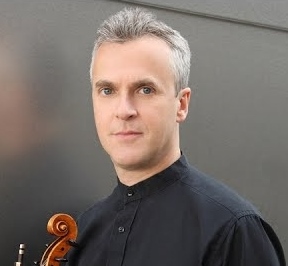 the composer. Yet it certainly doesn’t require fireworks for the soloists in the vein of Prokofiev or Liszt, so it’s up to the conductor to put a fire under its belly, which Dudamel did not do (he used a score, which is uncharacteristic). Thus, the 37-minute work — which fairly flew by even as it lacked propulsion — was pleasant when it could have been exciting. A few times out of sync, Ms. Martin’s piano part — showy but fairly easy — didn’t always gibe with Mr. deMaine, who could have been louder, and Mr. Chalifour, who could have used more character to balance things out. All three were fine, but needed a sense of urgency from Dudamel. Truly, this is one of those pieces that never seems to get a performance that does it justice: Even when Renaud and Gautier Capuçon and Jean-Yves Thibaudet performed this at the Hollywood Bowl with Dudamel, it was just OK.
the composer. Yet it certainly doesn’t require fireworks for the soloists in the vein of Prokofiev or Liszt, so it’s up to the conductor to put a fire under its belly, which Dudamel did not do (he used a score, which is uncharacteristic). Thus, the 37-minute work — which fairly flew by even as it lacked propulsion — was pleasant when it could have been exciting. A few times out of sync, Ms. Martin’s piano part — showy but fairly easy — didn’t always gibe with Mr. deMaine, who could have been louder, and Mr. Chalifour, who could have used more character to balance things out. All three were fine, but needed a sense of urgency from Dudamel. Truly, this is one of those pieces that never seems to get a performance that does it justice: Even when Renaud and Gautier Capuçon and Jean-Yves Thibaudet performed this at the Hollywood Bowl with Dudamel, it was just OK.
The concerto was sandwiched between two new music works. Esa-Pekka Salonen, who is directly responsible for hurling the Phil into the new century, premiered his 1996 19-minute LA Variations when he was Music Director in 1997. It’s fascinating to know from the notes that this is essentially variations on two chords, each consisting of six notes. This animated contemplation on life in L.A. (speedy and hectic, but with an easygoing vibe) sounds like a modernist take on Salonen’s fellow Finnish composer Sibelius with Stravinskyesque otherworldliness and impressionistic jazziness. The stage was barely able to contain the huge number of players so it was terrific fun to watch Salonen’s boundless innovations. Unyielding without being uninteresting, it was almost like a class in orchestration.
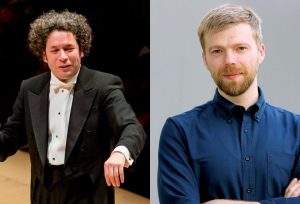 Here’s what really amazed me: easily one-third of the very full house did not return after intermission! Knowing that they were about to hear a brand new 45-minute work, had they had enough of modernism already? After hearing Los Angeles Chamber Orchestra’s presentation two weeks ago of Andrew Norman’s obnoxiously off-putting Try — all hammering, clunky, clamoring claptrap — I was reticent myself. I’m happy to report that Norman’s world premiere, Sustain, was far more agreeable, and a much more promising avenue for this young composer. It’s still that same old soundscape kind of music that desperately needs a sci-fi film to accompany it, so I suspect only the most die-hard Cal Arts student, possibly after a toke, would listen to this on their iPod. I still don’t see a big audience for this kind of music, regardless of how much it’s currently being promoted. Indeed, Sustain was commissioned for the Centennial by LA Phil, and the concert was being recorded.
Here’s what really amazed me: easily one-third of the very full house did not return after intermission! Knowing that they were about to hear a brand new 45-minute work, had they had enough of modernism already? After hearing Los Angeles Chamber Orchestra’s presentation two weeks ago of Andrew Norman’s obnoxiously off-putting Try — all hammering, clunky, clamoring claptrap — I was reticent myself. I’m happy to report that Norman’s world premiere, Sustain, was far more agreeable, and a much more promising avenue for this young composer. It’s still that same old soundscape kind of music that desperately needs a sci-fi film to accompany it, so I suspect only the most die-hard Cal Arts student, possibly after a toke, would listen to this on their iPod. I still don’t see a big audience for this kind of music, regardless of how much it’s currently being promoted. Indeed, Sustain was commissioned for the Centennial by LA Phil, and the concert was being recorded.
Will this be the music people will be listening to in a century when they look to the stars as their planet gets ever-hotter? While one can argue that Bruckner, Mahler, and Stravinsky were greeted with befuddlement at first, their music quickly caught on with critics and public alike. I’ve been hearing works very similar in construction to Norman’s monumental opus for over forty years, and not much has changed; a lot of it is positively inaccessible. Is that why so many patrons left at the interval? Well, it’s a shame they did, because this is precisely the kind of composition that demands to be seen live.
It begins with a tinkling piano. Then silence. Then soothing strings. Then silence. A longer phrase. One hit of a triangle. Horns and an oboe gently enter the increasingly eerie tone with some very light percussion backing them up. A plaintive flute floats with reverberating synth. Later, in a brilliant orchestration, the brass mimics the synth, while violins slide up to pitch and then play tremolos. Then, ever-building in volume and tempo, we reach a Bernsteinesque jazzy call-and-response in bursts of wahs, hums, and wild arpeggios. It’s so interesting and transporting that we can tolerate the repetitious composition. Naturally, there’s plenty of shimmering, but not on a gong — Norman uses giant wood planks! Later, Dudamel conducts not through meter, but pointing to instrumentalists who do soft riffs, ending in quiet.
Here’s the upshot: When Norman came on stage after the performance, there was no standing ovation. But when Dudamel had the players stand, the audience stood with them.
photos courtesy of LA Phil
Los Angeles Philharmonic
Walt Disney Concert Hall, 111 S. Grand Ave.
All-Russian Chamber Music
played Tuesday October 2, 2018
Dudamel Conducts Salonen, Beethoven & Norman
played October 4-7, 2018
for future events, call 323.850.2000 or visit LA Phil
